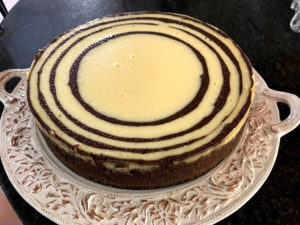
OpEds

Kingdoms rise and fall, but cheesecake rules on
For as long as I can remember, I have been one of the many cheesecake fans. I have been collecting recipes for many years and bought a cheesecake recipe book from Macy’s in New York as a memento in 1989.
My eyes are still drawn to cheesecake recipes and over the years, I have used any opportunity to try out new ones on my unwitting guests.
Cheesecakes are by no means a new invention and have been made in various forms for literally thousands of years. The earliest recorded cheesecake was on Samos in Greece more than 4 000 years ago. Cheesecake was a popular dish in ancient Greece, and was considered to be a good source of energy. In fact, small cheesecakes were served to athletes during the first Olympic Games held in 776 AD.
Athenaeus is credited with writing the first recorded recipe for cheesecake dating back to 230 AD. The constituents, listed as cheese, honey, and wheat flour were mixed together and heated in a brass pan. It was cooled down and then served.
With the Roman conquest of Greece, the secret recipe fell into Roman hands along with the other spoils of war. They modified the ingredients adding eggs, and baked it under a hot brick, serving it warm. Sometimes it was baked in pastry. Marus Cato is credited with recording the oldest Roman cheesecake recipe in the first century BC. Cheesecakes were often used as offerings to the gods in their temples.
As the conquering Roman armies expanded, cheesecake was introduced to Great Britain and Western Europe in 1 000 AD. Each country experimented with ways to put their unique spin on cheesecakes, and recipes started taking on different cultural shapes. In 1545, the first cookbook was printed describing cheesecake as a flour-based sweet food.
It was only in the 18th century that cheesecake would look like something we recognise today. In 1872, American dairymen achieved a technological breakthrough that ushered in the modern age of cheesecake. While trying to replicate a popular French cheese called Neufchatel, they accidently hit on a formula for a rich and creamy unripened cheese that they named cream cheese. Three years later, cream cheese was packaged in foil and distributed to stores under the Philadelphia Cream Cheese brand.
The classic New York cheesecake is a pure, unadulterated cheesecake with no fancy ingredients added to it or served on top or on the side. It was very popular in New York in the 1900s. In 1929, Arnold Reuben claimed that his family developed the first cream-cheese cake recipe. Legend goes that he was invited to a dinner party where his hostess served a cheese pie that he was so taken with that he experimented with various ingredients using her recipe until he came up with the much beloved New York style cheesecake.
Not to be outdone, other places in America put their unique stamp on the cheesecake – Chicago added sour cream to make it creamier; Philadelphia serves a lighter, creamier cheesecake with toppings; and St Louis has a butter cake sandwiching the cheesecake filling. Further afield, the Italians use Ricotta, the Greeks use Feta, and the Japanese use corn-starch and egg whites.
The only consistent ingredient is cheese, and even that varies. Whereas my daughters have found one recipe they think is “the perfect cheesecake”, I’ve not settled on a single recipe. I have recipes for both sweet and savoury cheesecakes. They can be bake or no-bake cheesecakes. In my time, I have made Rice Krispies bases and crumb crusts that are sometimes put into the deep freeze or baked in the oven. I have sampled cheesecakes with pastry bases, cake-like layers on the bottom or the top or both, and even cheesecakes sandwiched in phyllo pastry.
Traditional cheese cakes are rich and velvety with so many variations that one can never run out of recipes. I have added chocolate – white, milk, and dark so that the entire cheesecake is chocolate or the chocolate is swirled through the cheese mixture, or even that there are concentric alternating white and dark chocolate-flavoured rings. I have recently been given a recipe with condensed milk in the mixture. I have swirled raspberries through the cheesecake, and have made berry coulis toppings. I have mixed in mandarin pieces, and even have a recipe for a banana cheesecake. I have topped it with sour cream or crème fraiche, fruit or chocolate, nuts or biscuit crumbs.

One strives for a perfectly smooth cheesecake and in an attempt to achieve this, I have tried spraying the tin and using a water bath to prevent cracking. But cracks are easily disguised with toppings that can be baked on or poured over, adding to the flavour. The trick to telling when your cake is baked enough is the wobble test – it must wobble but not ripple! Cheesecakes are best left in the oven to cool down slowly, and can be left overnight and out the fridge until served the next day. This results in a soft cheesecake – if you want it to be firmer, refrigerate it overnight.
When I sent this article to my daughter to proofread, she thought I was heading down the avenue of concluding that cheesecakes are like people – there are many variations with differing purposes and generally all good! She was right.
- Dr Carron Zinman is a pulmonologist at the Linksfield Clinic, and a passionate cheesecake enthusiast.










